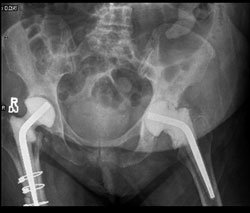Two-stage hip arthroplasty treatment effective in eliminating infections
An antibiotic cement prosthesis has proven to eradicate infection in up to 95% of patients.
The current gold standard for treating total hip arthroplasty infection is a two-staged implantation using antibiotic spacers. At the 25th Annual Current Concepts in Joint Replacement Winter meeting, one surgeon related his successful experience with method for eradicating infection.

Infection following total hip arthroplasty (THA) was traditionally treated through irrigation and debridement, along with excision arthroplasty, However, Wael K. Barsoum, MD, presented his experience with the current treatment alternative that is growing more popular as infections become more difficult to treat.
Barsoum discussed the increasing frequency of infection in the United States, which currently is approximately 1% and rising. “We clearly know that the infection burden in the United States is going up,” he said. “And not only are the numbers increasing, but the bugs we are dealing with are getting more and more challenging to manage.”
Use of antibiotic cement
The increasingly resilient nature of the infections being reported has made it necessary to find new ways of combating complications.
“Use of prostheses that have antibiotic loaded in the cement has been popular and shown promising results,” he said during his presentation. “Cases of recurrent infection have been shown to be quite low from 1997 to as late as 2004, but most of these are probably patients infected prior to 2000 with less virulent bugs than what we are dealing with today.”
In making his antibiotic-laden cement, Barsoum said he typically uses 6 g to 8 g of antibiotics per 40 g of cement.
Barsoum said it is possible to make a number of different antibiotic spacers, including static and mobile articulating spacers and cement. Different antibiotics are also available, and vary between single- and multi-agent.
All cement alternatives
|
Image: Barsoum WK |
Generally speaking, Barsoum reinforces most implants with a central metal core. All-cement implants are possible; however he does not recommend their use, citing their tendency to be more fragile than the alternatives.
“I would strongly argue against the all-cement implant,” he said. “When there is no metallic core, there is essentially no rebar in the cement, so these things tend to break. Any time we can make these in the operating room, right where the cement ends is where we end the spacer.”
Though the method is reported as being successful, it does come with complications. Barsoum listed several, including dislocations and perioprosthetic fractures.
Typically, Barsoum said, he will try to reduce a dislocation only once. With subsequent dislocations, so long as the patient remains neurologically intact, he will simply leave it be.
Advantages of treatment
Barsoum cited a Taiwanese study, labeling the results achieved with the spacers as “very promising.” The advantages are many, with antibiotic cement prostheses preserving the soft tissue tension and space around the hip joint providing easier and faster exposure at the time of the second-stage of the reimplantation.
“[The paper] shows very good results at the time of replantation, with significantly decreased blood loss, decreases in the length of stay, a decrease in blood transfusions for these patients, and in addition, this paper showed significantly improved function when the patients were walking around with these spacers as opposed to antibiotic beads,” he said.
Success rates for eradicating infection with the a two-stage antibiotic spacer procedure have been shown to fall between 85% and 95%.
For more information:References:
- Wael K. Barsoum, MD, can be reached at The Cleveland Clinic Foundation, 30033 Clemens Road, Westlake, OH 44145; 440-808-4682; e-mail: barsouw@ccf.org. He holds intellectual property rights with Exactech; is an advisory board member for OtisMed Corp.; is an independent contractor for Smith & Nephew Orthopaedics and Tissue Link Medical; is a consultant and independent contractor for, and receives speaking and teaching renumerations from Stryker and is a consultant for and receives intellectual property rights from Wright Medical Technology.
- Barsoum, WK. The use of antibiotic hip spacers: the two stage solution. Presented at the 25th Annual Current Concepts in Joint Replacement Winter Meeting. Dec. 10-13, 2008. Orlando, Fla.
- Hsieh PH, Shih CH, Chang YH, Lee MS, Shih HN, and Yang WE. Two-stage revision hip arthroplasty for infection: Comparison between the interim use of antibiotic-loaded cement beads and a spacer prosthesis. J Bone Joint Surg (Am). 2004;86:1989-1997.

